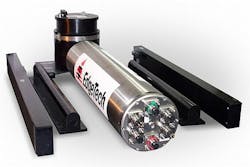Navy chooses imaging sonar systems from EdgeTech to support of arctic research projects
SAN DIEGO, 10 Aug. 2015. U.S. Navy submarine research experts needed imaging sonar systems to help evaluate the performance of nuclear-powered submarines operating in the arctic. They found their solution from EdgeTech in West Wareham, Mass.
Officials of the Naval Supply Systems Command Fleet Logistics Center in San Diego announced plans last week to buy two model 2200 modular side-scan sonar systems on a sole-source basis from EdgeTech. The value of the upcoming contract has yet to be negotiated.
The EdgeTech model 2200 is a compact and configurable sonar system for manned submarines and unmanned underwater vehicles (UUVs). It can be configured to collect side-scan sonar imagery, sub-bottom profiles, and bathymetric data.
Navy experts will install these systems aboard Navy submarines to support the U.S. Navy Arctic Submarine Laboratory (ASL). They help with submarine arctic operations and performing research to measure, monitor, and track systems while evaluating operational performance of nuclear submarines in the arctic.
Subsea units can be depth rated from 0 to 20,000 feet. The system can accommodate EdgeTech’s underwater imaging technologies called Full Spectrum CHIRP Processing, Multi-Pulse technology, Dynamic Array Focusing, and Dynamic Aperture Sonar Arrays.
Related: Teledyne boosts expertise in imaging sonar and UUV technology with acquisition of RESON A/S
CHIRP Processing enhances long range resolutions through improved signal-to-noise ratios. Multi-Pulse technology puts as many as four pulses in the water simultaneously to enhance system speed or resolution. Dynamically Focused Arrays, meanwhile, sharpen resolutions in the far field and improve target identifications at long ranges.
The EdgeTech 2200 offers sid-scan sonar frequencies from 75 to 1600 kHz; sub-bottom frequencies from 500 Hz to 24 kHz; bathymetry capabilities with swath coverage and no nadir gap; simultaneous dual frequency operations; tri-frequency option: 230 kHz, 540 kHz and 1600 kHz; single or dual frequency dynamically focused arrays; multi-pulse operation; and on-line self-test and status reporting.
Applications include archeological surveys; geological and geophysical surveys; sediment classification; cable and pipeline surveys; pre and post dredging surveys; scour and erosion investigation; marine construction surveys; benthic habitat mapping; dredging operations; marine debris search; military rapid environmental assessments (REA); port and harbor security; route surveys; shallow water hydrographic surveys; and mine countermeasures (MCM).
The Navy is buying the sonar sole-source because EdgeTech is the original equipment manufacturer, and has certified the system to Navy requirements. Only the EdgeTech product has been proven to be compatible with existing submarine. Certifying another sonar would be too expensive and time consuming, officials say.
For more information contact EdgeTech online at www.edgetech.com, or the Naval Supply Systems Command Fleet Logistics Center-San Diego at www.navsup.navy.mil.

